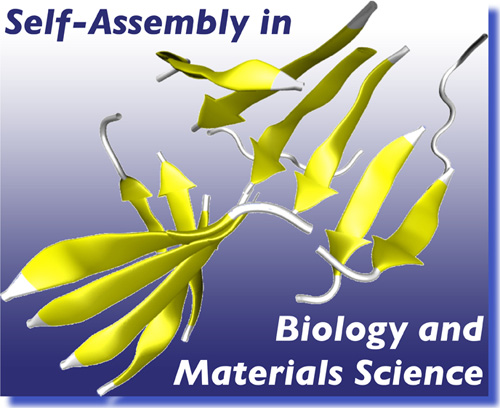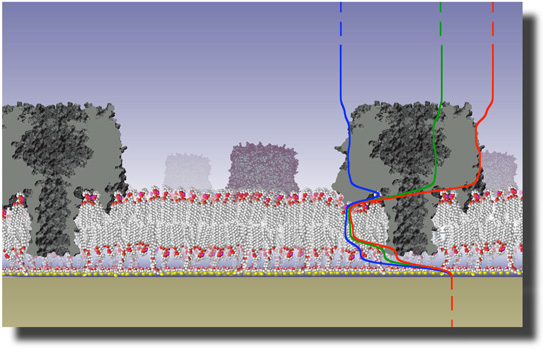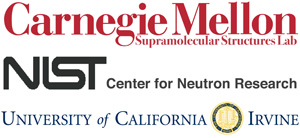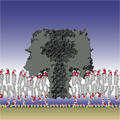| |
|
|
News and Events
Workshop on molecular Self-Assembly in Biology and Materials Science, June-08 to June-12, 2010
 Mahias Lösche and Jaime Ruiz-Garcia of the Universidad Autonóma de San Luis Potosí in México are the co-organizers of a bilateral, U.S./Méxican workshop on Self-Assembly in Biology and Materials Science that takes place in Bahias de Huatulco, Oaxaca province, México, between June-08 and June-12, 2010. This workshop is jointly funded by the U.S. NSF and the Méxican CONACyT. The generous funding by these agencies support the participation of more than 30 senior researchers, mostly at the faculty level, as well as post-docs and graduate students. Besides fostering science communication, the workshop will provide an environment for the establishment and continuation of joint research initiatives between the Méxican and U.S. scientific research communities working in these areas. Mahias Lösche and Jaime Ruiz-Garcia of the Universidad Autonóma de San Luis Potosí in México are the co-organizers of a bilateral, U.S./Méxican workshop on Self-Assembly in Biology and Materials Science that takes place in Bahias de Huatulco, Oaxaca province, México, between June-08 and June-12, 2010. This workshop is jointly funded by the U.S. NSF and the Méxican CONACyT. The generous funding by these agencies support the participation of more than 30 senior researchers, mostly at the faculty level, as well as post-docs and graduate students. Besides fostering science communication, the workshop will provide an environment for the establishment and continuation of joint research initiatives between the Méxican and U.S. scientific research communities working in these areas.
Enter the workshop website here.
|
Alex Evilevitch accepts offer to join Biological Physics group at CMU
 Alex Evilevitch joins the CMU Physics Dept., accepting an offer extended earlier within the department's Biological Physics Initiative. Within this initiative, Alex will head the second new experimental group (after the Lösche group formed in 2005). Both experimental groups are complemented by Markus Deserno's theoretical and computational group formed in 2007. Alex Evilevitch joins the CMU Physics Dept., accepting an offer extended earlier within the department's Biological Physics Initiative. Within this initiative, Alex will head the second new experimental group (after the Lösche group formed in 2005). Both experimental groups are complemented by Markus Deserno's theoretical and computational group formed in 2007.
Alex' work focuses on virus biophysics. Viral capsids, with diameters between 10 and 100 nm, protect genomes that are tens of microns in contour length. The majority of viruses possess icosahedral protein shells with thicknesses of only a few nanometers — a single protein layer. Yet, viral particles are stable enough to withstand huge internal forces, exerted by its packaged genome, and external forces from its environment. On the other hand, they must be sufficiently unstable to rapidly release their genome into target cells during infection.
There is thus a unique match between the virus’ genome length and capsid size and strength which is uniquely adjusted to the biological and physical properties of the host cell. Internal genome pressure, reaching tens of atmospheres as a result of strong confinement, is required for phages and many other dsDNA viruses to infect by passive ejection of their genomes. Determining the complex details of these apparently simple interrelations is the focus of research activities of the Evilevitch group. Besides investigating the structural and physico-chemical details of packaged, highly charged linear polymers within the capsids, the group also discovered that the packaged genome provides additional strength to the viral capsid by supporting the fragile structure from the inside — helping the virus survive external stress imposed on it between infection cycles.
More info on the Evilevitch group at Lund can be found here.
|
Dec. 2008/Jan. 2009:
Two key lab publications appear in the Biophysical Journal
Accounts of our research on the interaction of Aβ oligomers and of α-hemolysin with tethered lipid bilayer membranes (tBLMs) have recently appeared in BJ:
G. Valincius, et al., Soluble amyloid β oligomers affect dielectric membrane properties by bilayer insertion and domain formation, Biophys. J. 95 (2008), 4845.
D. J. McGillivray, et al., Structure of functional Staphylococcus aureus α-hemolysin channels in tethered bilayer lipid membranes, Biophys. J. 96 (2009), 1547.

|
An NIH Program Grant (1P01 AG032131) is awarded to CMU. We receive generous support for enhancing our research into molecular aspects of Alzheimer's disease. The program is a collaboration between the Deserno and Lösche groups at CMU, the Hall and Glabe labs at UC Irvine and the Valincius group in Vilnius.
Much of the experimental work in this project will be performed at the NIST Center for Neutron Research. We also collaborate with Ralf Langen's group at USC on the deuteration of Aβ peptides for neutron reflectivity measurements.

|
 AHAF grant awarded for research on AD AHAF grant awarded for research on AD
The American Health Assistance Foundation awards a 2-year Pilot Award to the Lösche lab for research into the interaction of Aβ peptide oligomers with membranes. This grant will help boost our biomedical research activities using tethered bilayer lipid membranes (tBLMs). More ... |
Nanoscale Engineering of the Biointerface
A Max-Planck / NSF Graduate Research School on Polymer Materials
Hotel Cap Roig, Playa del Aro, Spain, May-26 – June-01, 2007.
|
Physical and Chemical Aspects of Molecular Biology
An International Workshop on Current Problems in Complex Fluids,
Hotel Camino Real, Puebla, México, January 4 – 6, 2007.
|
|
|
|


 Alex Evilevitch joins the CMU Physics Dept., accepting an offer extended earlier within the department's Biological Physics Initiative. Within this initiative, Alex will head the second new experimental group (after the Lösche group formed in 2005). Both experimental groups are complemented by Markus Deserno's theoretical and computational group formed in 2007.
Alex Evilevitch joins the CMU Physics Dept., accepting an offer extended earlier within the department's Biological Physics Initiative. Within this initiative, Alex will head the second new experimental group (after the Lösche group formed in 2005). Both experimental groups are complemented by Markus Deserno's theoretical and computational group formed in 2007.


 AHAF grant awarded for research on AD
AHAF grant awarded for research on AD